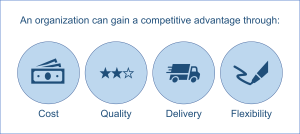2.2 Designing Supply Chain Strategies
Designing supply chain strategies is a proactive process that requires careful planning and resource allocation. It is not something that should be allowed to emerge organically without direction. The development of supply chain strategies requires the involvement of both supply chain professionals and top management. Supply chain professionals bring their operational expertise and understanding of the supply chain’s intricacies, while top management ensures alignment with the organization’s broader strategic objectives.
2.2.1 Environmental Scanning
The first step in designing a supply chain strategy is environmental scanning. This involves examining the external environment in which the organization operates to identify opportunities and threats. A commonly used tool for environmental scanning is the PESTEL analysis, which considers Political, Economic, Sociocultural, Technological, Environmental, and Legal factors.
Environmental scanning is crucial because it helps us understand the context in which we operate. The environment can mean many different things – from the political climate to the state of the economy, from societal trends to technological advancements, from environmental considerations to legal regulations. To help us channelize our efforts, we have models like PESTEL analysis that help us focus on different environmental factors. By understanding these factors, we can anticipate challenges and opportunities, and design our supply chain strategies accordingly. Below is an example of a PESTEL analysis on Nike.
For example, a company in the renewable energy sector might consider the following PESTEL factors:
- Political: Government policies supporting renewable energy.
- Economic: The cost of renewable energy technologies compared to traditional energy sources.
- Sociocultural: Public attitudes towards renewable energy and climate change.
- Technological: Advances in renewable energy technologies.
- Environmental: The impact of energy production on the environment.
- Legal: Regulations related to energy production and emissions.

2.2.2 Internal Scanning
Internal scanning is a crucial part of designing a supply chain strategy. It involves examining the organization’s strengths and weaknesses, which are integral to understanding how the supply chain can leverage its internal capabilities and address its limitations. A commonly used tool for internal scanning is the SWOT analysis, which considers Strengths, Weaknesses, Opportunities, and Threats.
For instance, a company in the renewable energy sector might conduct a SWOT analysis as follows:
- Strengths: The company might have a strong research and development team that is capable of innovating and developing new renewable energy technologies.
- Weaknesses: The company might have limited financial resources for large-scale production, which could limit its ability to meet high demand.
- Opportunities: The growing global emphasis on sustainable energy sources could present significant opportunities for the company to expand its market share.
- Threats: The company might face intense competition from traditional energy companies that have more financial resources and established market presence.
Understanding these internal factors allows an organization to leverage its strengths and address its weaknesses in its supply chain strategy. For example, a company with a strong logistics network might leverage this strength by focusing on a strategy that emphasizes fast delivery times. Conversely, a company with weak supplier relationships might focus on improving these relationships or diversifying its supplier base. This internal scanning process is essential for developing a supply chain strategy that is aligned with the organization’s internal capabilities and strategic objectives.
2.2.3 Competitive Priorities
Once the environmental and internal scanning have been completed, the organization needs to decide how it wants to compete in the marketplace. This decision is based on the organization’s unique strengths, the opportunities identified in the market, and the competitive landscape. The organization must determine its competitive priorities, which are the areas where it chooses to focus in order to gain a competitive advantage. These priorities should leverage the organization’s strengths and align with the opportunities identified in the market.
Competitive priorities include cost, quality, delivery, and flexibility.
- Cost: Some organizations focus on being the low-cost provider in their market. For instance, Walmart has built its entire business model around offering low prices to customers.
- Quality: Other organizations prioritize offering high-quality products or services. Apple, for example, is known for the high quality of its products and can charge premium prices as a result.
- Delivery: Some organizations focus on delivering products faster or more reliably than their competitors. Amazon, for example, has made fast and reliable delivery a cornerstone of its business model.
- Flexibility: Finally, some organizations prioritize flexibility, which could mean the ability to customize products to individual customer needs or to respond quickly to changes in demand. Dell, for instance, was known for its ability to customize computers to individual customer specifications.

In addition to these competitive priorities, it’s important to understand the concepts of order winners and order qualifiers. Order winners are the factors that directly contribute to winning business. They are the attributes of a product or service that differentiate a company from its competitors and make customers choose one company over another. On the other hand, order qualifiers are the minimum standards that a product or service must meet to be considered by customers.
For example, in the smartphone market, innovative features or superior design could be order winners that make customers choose one brand over another. At the same time, a certain level of performance and functionality would be considered order qualifiers that all smartphones must meet to be considered by customers. Similarly, in the automobile industry, fuel efficiency might be an order winner for a certain segment of customers, while safety features would be an order qualifier that all cars must have to be considered by customers.

Understanding the difference between order winners and order qualifiers is crucial for setting competitive priorities. Companies need to ensure that they meet the order qualifiers in their industry while focusing their resources and efforts on developing and enhancing their order winners.
Trade-offs are a critical consideration in setting competitive priorities. It’s challenging to achieve excellence in all areas simultaneously. For example, offering high-quality, customized products can be expensive and may make it difficult to compete on cost. Similarly, focusing on fast delivery might require keeping large amounts of inventory, which can increase costs and reduce flexibility. This demonstrates that a firm generally cannot excel in all competitive priorities due to these inherent trade-offs. For instance, Walmart excels in cost-efficiency but does not focus on offering high-end, premium products. Conversely, Apple excels in providing high-quality, innovative products but does not compete on being the low-cost provider. Therefore, firms need to make strategic choices about which competitive priorities to focus on, based on their capabilities and market positioning.
Based on the competitive priorities, order winners, and order qualifiers, firms can formulate a supply chain strategy. However, strategy making and review is a continuous process. As the external environment changes and as the organization’s internal competencies evolve, supply chain strategies must be adjusted accordingly. For example, Dell, once known for selling computers directly to consumers, changed its strategy and began offering its products in retail stores. This shift was in response to changes in the market and consumer buying habits.
In conclusion, setting competitive priorities is a critical step in designing a supply chain strategy. These priorities should reflect the organization’s unique strengths, align with market opportunities, and guide the organization’s decisions about how to compete in the marketplace. Regular review and adjustment of the strategy are necessary to ensure it remains aligned with the changing environment and the organization’s evolving capabilities.
